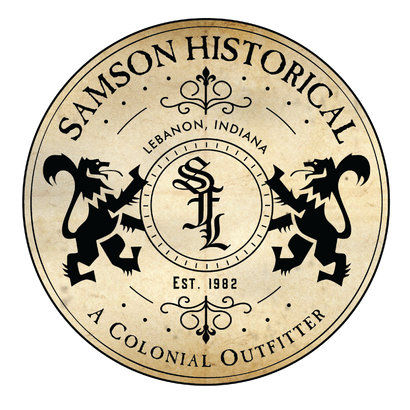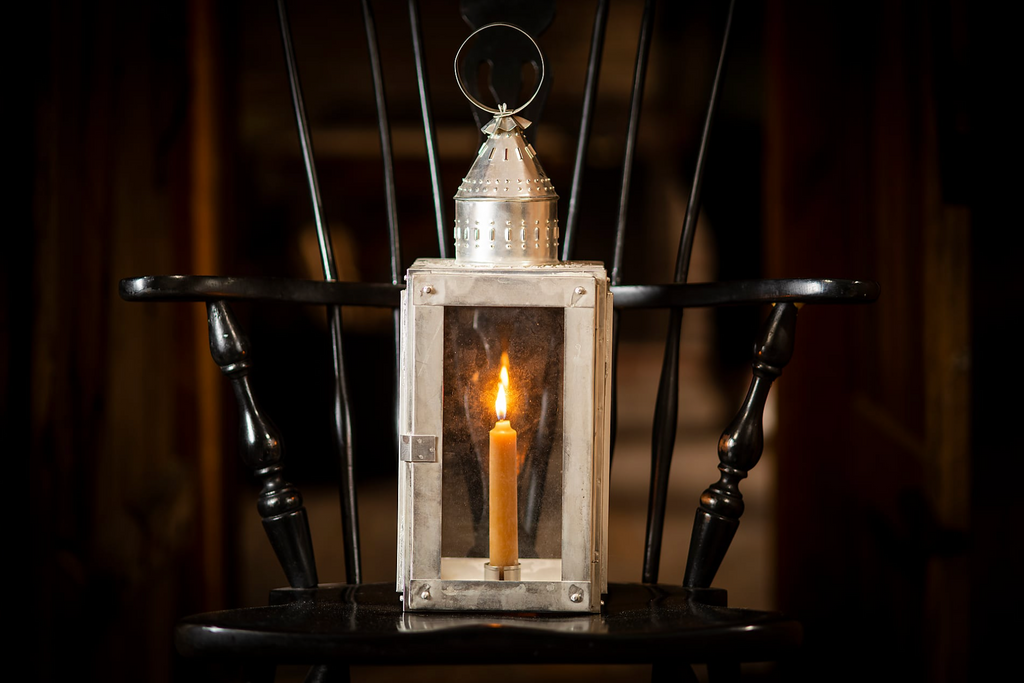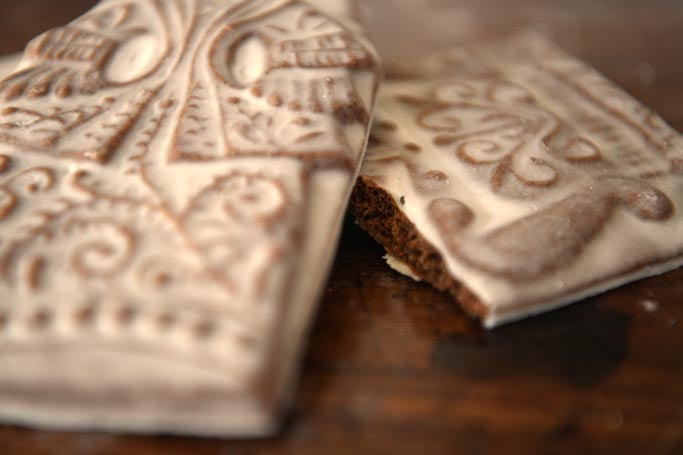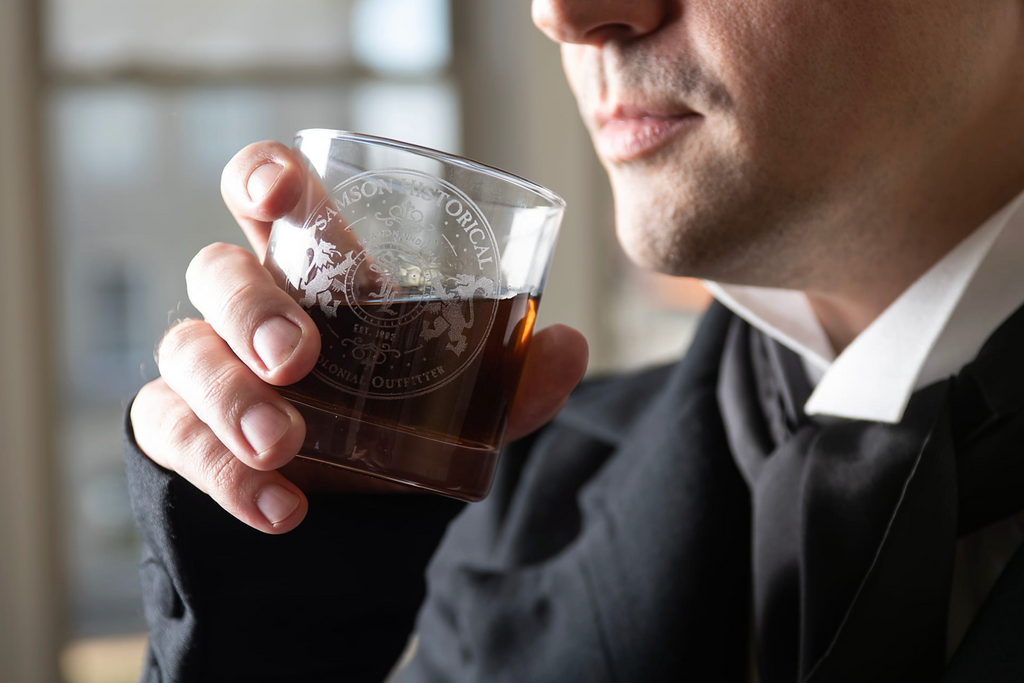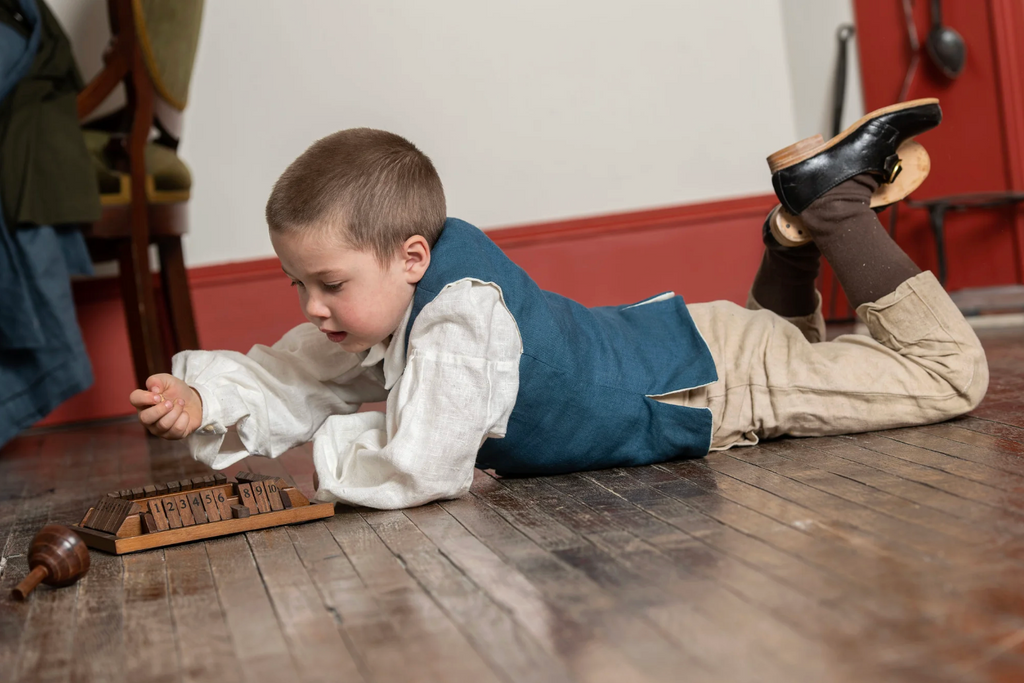Men’s Clothing
Women’s Clothing
Children's Clothing
A Warm Cup Of Cheer
by Hannah Reece 12 min read

Article by Gail McLaughlin
Alcohol was a staple in the eighteenth century and was drunk from rising in the morning to retiring in the evening. While cocktails were still a far-off thought, the colonists enjoyed alcoholic beverages with names such as Posset, Toddy, Flip, and Syllabub. The term eggnog first came into use in 1775. This popular holiday drink has a history that goes back to Medieval Britain, although it has been associated with Christmas since the 1700s.
What is Eggnog?
The Oxford English Dictionary defines eggnog as: "a drink in which the white and yolk of eggs are stirred up with hot beer, cider, wine or spirits." It was made from "hot milk curdled with ale, wine or other liquor, flavored with sugar, herbs, spices, etc., and often drunk for medicinal purposes." This is most likely how eggnog became associated with the holidays as it was drunk in the colder months.
Eggnog itself came into being sometime in the eighteenth century in Colonial America and was most likely a form of posset. Medieval monks in thirteenth-century Britain first made posset. The monks would mix warm ale with hot curdled milk, eggs, and available spices to sweeten it. Some monks would also add figs to the mixture. The added alcohol kept the mixture from spoiling.
During the seventeenth and eighteenth centuries, posset was served as a wine punch at the social gatherings of Britain's upper class and used to toast to the health and prosperity of family and friends and to flaunt their wealth. According to Kiri Tannenbaum, "In the winter, the wealthy would drink warm milk and egg beverages seasoned with pricey spices such as ground nutmeg and cinnamon and expensive liquors like brandy and sherry to keep it from spoiling." The lower classes in Britain could not afford the ingredients; they rarely even saw a glass of milk.
Posset goes to America
There is much debate as to when posset, known colonists as eggnog, immigrated to the colonies but was most likely with the British Aristocracy. The wealthy continued to put sherry and brandy into their eggnog punch while the average person used rum. Rum was affordable and in plentiful supply. Rum imported from the British Caribbean was plentiful though more expensive than the American made drink. Before the Revolutionary War, there were hundreds of rum distilleries, many located in New England. American made rum was very cheap compared to imported, though the imported was of much better quality. In 1740 a gallon of American rum would cost 1 shilling and 8 pence. Caribbean rum sold for 2 shillings and 5 pence. There were also numerous farms making the supply of eggs, milk, and cream available to almost everyone. Rum would eventually be replaced by American made whiskey closer to the American Revolution.

Eggnog was made in private homes and taverns. Taverns in the eighteenth century were gathering places. They provided beds for travelers, meals, alcoholic beverages, and news. Men from the town and farms would gather to hear news of the other colonies from travelers. Much of the American Revolution was planned in taverns.
Another milk drink specific to the colonies was flip. Flip is very similar to eggnog. According to Casey Barber, "to make an ale flip, beer and rum were mixed in a pitcher, often along with eggs or cream to thicken the drink and a few spoons full of sweetener like molasses, cane sugar, or dried pumpkin. A poker was heated in the fire until red-hot and then used to whip the drink, making it frothy and warm while adding caramelized flavor. Pouring the ale flip between two mugs added velvety texture to the already-creamy drink."
Why drink so much alcohol?
In Europe, many sources of water were polluted, so they substituted alcohol. When immigrating to the colonies, people naturally had the same distrust of water sources. Many water sources were from shallow wells or small streams, which could be full of bacteria and other particles. While most water was safe to drink in America, even river water would have mud in it, which would have to settle to the bottom before the water could be used. Alcohol, whether ale, rum, wine, or whiskey, was consumed as it was considered to be the safer alternative. They also believed that alcohol warded off illnesses and helped them to recover from colds, cases of flu, stomach ailments, depression, and other such maladies.
In the seventeenth and eighteenth centuries, New England's economy relied almost entirely on the ability to trade lumber and fish. There was little need for this commodity back in Britain. They began trading their goods to the British owned colonies of the West Indies. They also traded with the French and Dutch-owned islands, which proved to be more profitable. The West Indies' main export was sugar. Molasses, a by-product of sugar, became a profitable export. The molasses was used by the colonists in the manufacturing of rum.
By the early eighteenth-century, the American colonists not only imported rum but began distilling their own, and they needed molasses. Plantation owners needed slaves for the hard-manual labor, and Africa wanted the less expensive rum distilled by the colonists. This led to the birth of what is known as The Trade Triangle. The rum distilled in America was traded to Africa for slaves; the slaves were traded to the West Indies for molasses and sugar, the molasses was sent back to New England to distill rum.
Taxed to the death
Great Britain needed money. They had been at war since September 1715 with the uprising of the Jacobites in Scotland. In 1739 Britain declared war on Spain, which was mostly fought in the Caribbean. In May of 1756, Britain went to war with France, beginning the Seven Years' War. Britain and her allies fought France in the American Colonies, India, and Europe. Austria and Russia and eventually Spain joined forces with the French. In 1763 Britain emerged victoriously, but the wars depleted the British treasury. In order to refill the treasury, Charles Townshend, the Chancellor of the Exchequer proposed that Parliament begin to levy taxes on the North American colonies on select British exports. The goods to be taxed included glass, paint, lead, and tea. This act was repealed in 1770 to appease the colonists, but the levy on tea remained in effect. Up to this point, there was no tax on goods imported from the West Indies.
It did not take long for there to be a conflict between the New England colonies and Great Britain over imports from the West Indies. British imports from the West Indies, while not taxed, were far more expensive than the French, Dutch, and Spanish products. Colonists found it was far more profitable to deal with these countries instead. To counteract the loss of revenue, the British Parliament introduced The Sugar and Molasses Act of 1733. This act intended to limit trade outside the empire. The Act imposed high taxes, six pence per gallon on molasses not produced by the British. As a result, smuggling molasses became commonplace as the British had little means of collecting the levy.
Due to the war between Great Britain and France, the sugar and molasses trade was in crisis. The Sugar and Molasses Act of 1733 was ineffective. Corruption and smuggling were hurting the British market for sugar and rum. At this time, Lord Grenville was the First Lord of the Treasury and Chancellor of the Exchequer. He was working with Parliament to bring the colonies into line. In 1764 Parliament refined the Sugar and Molasses Act by reducing the tax from six pence to three pence but included more foreign goods to be taxed, including sugar, certain wines, coffee, cambric, printed calico, and pimiento. It also further regulated the export of lumber and iron. Parliament decreed that the duties would be enforced using the British navy, appointing customs commissioners, and issuing writs of assistance. Opposition to this act led to increased smuggling and corruption. By 1764 smuggling was seen as an act of patriotism. However, this act led to a decline in the rum industry in the colonies. The effects of this act reduced trade with Madeira, the Azores, the Canary Islands, and in particular, the French West Indies. These were essential ports for colonial trade.
The making of rum
Rum had its humble beginnings as a by-product of West Indian sugar. The West Indies have Christopher Columbus to thank for the lucrative crop. He took sugar cane from his father-in-law's sugar plantation in Madeira, Portugal, to the Caribbean in 1493, giving Spain domination over the islands. Spain's dominion did not last long. Britain, along with the French, Dutch, and Danes broke Spanish domination of the Caribbean islands beginning in 1609 with the British conquest of Bermuda. Sugar plantations flourished in the Caribbean, and by the seventeenth century, there were hundreds of sugar plantations and refineries. In order to run the plantations and be profitable, slaves became as much a commodity as the sugar and molasses the plantations produced.
Rum is made with molasses, which was thought to be waste once the sugar was ready. Once harvested, the sugar cane was crushed, and the juice ran into collecting pans connected to a boiling house containing the large holding tank. Once all the juice was collected, it ran into a copper vat or bowl. From here, it was boiled and skimmed several times. Once it was deemed ready, the reduced cane juice was cooled and transferred to clay pots with drainage holes. The refined juice was left for several days, during which time a sticky caramelized goo seeped out of the pots. In turn, the molasses was either fed to slaves and livestock, used with lime and horsehair to make mortar, concocted into a treatment for syphilis, which was utterly ineffective or thrown into the sea as waste.

It is unknown when molasses was first fermented into alcohol. According to Britannica.com, rum was first mentioned in records from Barbados around 1650. The slaves working on the sugar plantations were the first to realize molasses could be fermented into alcohol. They called it "kill-devil" or "rumbullion." By 1667 they shortened it to "rum." A visitor to the island of Barbados, Richard Ligon, described the drink as "throat searing" and "not very pleasant." Other critics called it "rough and disagreeable" or "hot, hellish, and terrible." Despite this description, rum sales were on the rise.
By the early 18th century, almost all the rum exported from the West Indies went to North America. In the years between 1726 and 1730, nearly 900,000 gallons from Barbados and Antigua were shipped to the colonies. While the colonists continued to import rum, they soon began distilling their own. It was also a standard ration for sailors. Edward Vernon, an Admiral in the British Navy, was the first to note that rum was interfering with the competency of the sailors and ordered the drink to be mixed with water. The sailors were happy as long as they still got their ration of rum. They named the watered-down rum grog.
Whiskey, the new rum
As a result of the tariffs imposed on non-British imports, notably molasses, rum began to wane in popularity during and after the Revolutionary War. This was when whiskey began to gain a foothold. Although made in America before the war, it was limited to farmers who had a surplus of grain. Lacking the raw material to distill rum, American colonists turned to whiskey production. Not only was grain available in quantity to the colonists, but it also enabled the colonists to establish a new identity and reduce their reliance on the British. It quickly gained in popularity, particularly in the southern colonies. In the south, eggnog would be mixed with whiskey and in the north rum.
According to legend, whiskey was not a new invention. Irish monks, while traveling in the Middle East during the Crusades, realized the copper alembics they saw for the production of perfume could be used to produce medicinal spirits. An alembic is a vessel with a beaked cap or head, formerly used in distilling.
Whiskey comes from the Gaelic for "water of life"—uisgebeatha or whiskybae. Just about any grain can be used to make it, but barley was traditionally used in Ireland and Scotland. Many Scotch-Irish immigrants were skilled at distilling whiskey. They were settled in four states, Pennsylvania, Maryland, Western Virginia, Kentucky, and western North Carolina. It was not long before Kentucky, particularly Bourbon County, would be recognized for producing a quality product. They had readily available corn, limestone-filtered water, and hardwood to make barrels.

After leaving office George Washington, looking for ways to make Mount Vernon more prosperous, turned to the distillation of whiskey. His plantation manager, James Anderson, a Scott Immigrant, suggested a distillery pointing out that Mount Vernon had the crops, a gristmill, and an abundant supply of freshwater. Anderson first used a nearby cooperage building, but that quickly became too small. In 1797 construction began, and soon there was a separate stone house containing five copper pots or stills holding a total of 616 gallons, 50 mash tubs made of oak to cook and mash the grain, and a boiler which held 210 gallons of water. Once ready, the whiskey was poured into wooden barrels and shipped to local merchants. Whiskey in the eighteenth century was not aged. It more closely resembled moonshine. Washington realized that the waste produced from the distillery made hearty slop for his pigs. He was said to have some of the fattest pigs around. Another well-known fact about George Washington, he loved eggnog. He had his hand-written recipe.
What is in a Name?
There are many theories on how eggnog got its name. The egg part seems relatively straight forward with eggs as the main ingredient. The second half, nog, is not as simple and has led to much speculation. Some believe that it was named for the small wooden cups called "noggins" that were used during the eighteenth century to serve the drink and egg, and noggin were naturally put together. Another theory comes from the sailors' term for the watered-down rum they were given in their rations, grog. The word egg and grog became eggnog. According to the Oxford English Dictionary, the beverage got its name from an ale brewed in East Anglia. The ale was robust and served warm by placing a hot poker in it before being served. No matter where the beverage got its name, it has been in use since 1775 in the American colonies. It is possible it was being used in Britain, but there is no written record of it until the mid-1820's making it an American term.
Drinking Vessels of the eighteenth century
There were many different kinds of vessels used for drinking and storing beverages in the eighteenth century. The most popular were small vessels known as beakers, canns, and mugs. All vessels, no matter what shape or size, were made of different materials including wood, glass, silver, tin, pewter, and earthenware.
- Cann refers to a metal tumbler without handles.
- Mug referred to any large cup with a handle.
- Bottle meant any vessel that can contain liquors and are made from leather, glass, stone, or wood.
- A bumper or brimmer were trendy names for glasses or cups used when making toasts. They more than likely got the name from bumping or banging the glass on the bar or table after the toast for emphasis.
- Biggin was any small bowl or cup.
- Bowl was used for any small round container.
- Blackpots or Blackjacks were popular for the average American. In Britain, it was used by the lower class, such as shepherds and country folk. It was made of heavy leather. It was waxed or varnished to make it look appealing and kept it from absorbing moisture. Some were plain but could be decorated with silver. It is said that a Frenchman visiting Britain returned to France, exclaiming that the British drank out of their boots.
- Large bowls were used to mix a variety of drinks, including eggnog.
- According to the New York Times, in 1775, Samuel Johnson described a tankard as "a large vessel with a cover for any strong drink." A tankard could be made from a variety of materials, including wooden staves which were hooped together, glass, leather, or earthenware of good size with a lid and handle.
- Another type of tankard brought to America was called a hoop pot. These were fashioned with staves bound together. A dictionary from the 18th century described the hoop pot as a quart pot generally made with three hoops. They were designed to be passed around, and each drinker had his own hoop or third. There were three sections holding eight ounces each.
- Posset was made using a posset pot. These pots date back to the middle ages and are made of ceramic or metal. The pot resembled a large teapot with a spout and two handles. Posset was a drink but also at that time eaten as a dessert. The gruel floating on the top was thick and sweet. The spout allowed the liquid to be drunk separately, and a spoon was used to eat the sweet stuff floating on top.
Over the years, there have been many recipes for eggnog, next to George Washington's recipe, the first recorded recipe appears in Jerry Thomas' Bartenders Guide or How to Mix Drinks, which was first published in 1862. If you are not faint of heart, I would suggest George Washington's personal recipe.
—mix liquor first,
then separate yolks and whites of 12 eggs,
add sugar to beaten yolks,
mix well.
Beat whites of eggs until stiff and fold slowly into mixture.
Let set in cool place for several days.
Taste frequently.
Want to give it a try in true 18th Century Fashion? We recommend enjoying it solo from our Small Onion Bottle or Small English Pipkin. Among friends we recommend using our Pitcher and Gil Set!
Leave a comment
Subscribe
Sign up to get the latest on sales, new releases and more …
